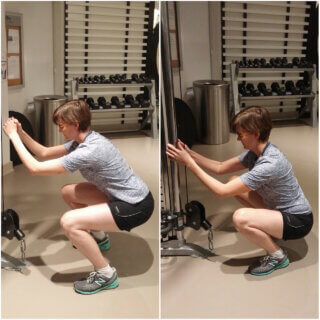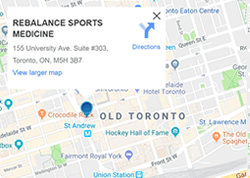Reclaim Your Squat Part 2 – The Role of Motor Control
 In the previous entry, we discussed the main mobility issues related to squatting. Today we will explore what motor control means, and how to safely incorporate it into an exercise routine to improve your squat technique.
In the previous entry, we discussed the main mobility issues related to squatting. Today we will explore what motor control means, and how to safely incorporate it into an exercise routine to improve your squat technique.
Motor control is an interaction between the central nervous system and the musculoskeletal system to efficiently move and coordinate our body through movement. A simple squat can require a great deal of motor control. Beginners and even seasoned power lifters can struggle with controlling their body, especially their core and low back in the deep squat position. Retraining motor patterns by practice and repetition will not only fix form, but can also prevent injuries.
How to Decide if You Have a Mobility or Motor Control Issue
First a physiotherapist can properly assess the range of motion available in the hips, knees and ankles, and provide you with the tools to resolve any restrictions. For information on how to perform a proper squat and look at sample mobility exercises refer to the previous blog titled “Reclaim Your Squat Part 1 – Mobility”
 Another easy way to test mobility vs. motor control is shown in the picture below.
Another easy way to test mobility vs. motor control is shown in the picture below.
- First squat with proper form as low as you can (left picture)
- Try the same movement while gently holding on to a bar or doorframe (right picture)
If you can squat deeper with the second technique, you need to work on controlling your body throughout movement. For experienced power lifters, the loss of lumbopelvic control or rounding of the low back (commonly referred to as a “butt wink”) at the bottom of their squat could also mean motor control issues. The challenge for the body is to move through the entire available range of motion while properly stabilizing the low back to keep it in neutral.
Three Progressive Exercises for Motor Control
Core/ inner unit activation
 The role of the inner unit is to provide a small anticipatory support to the low back BEFORE the trunk or limbs move. For example, when you reach in the fridge to get the milk, some of your muscles tense up before the actual lifting movement happens. This small automatic muscle contraction can be affected after dealing with low back pain, pregnancy, or certain abdominal surgeries. Even if the inner unit is working properly, learning to isolate it can be a challenge. As a start, try the following steps:
The role of the inner unit is to provide a small anticipatory support to the low back BEFORE the trunk or limbs move. For example, when you reach in the fridge to get the milk, some of your muscles tense up before the actual lifting movement happens. This small automatic muscle contraction can be affected after dealing with low back pain, pregnancy, or certain abdominal surgeries. Even if the inner unit is working properly, learning to isolate it can be a challenge. As a start, try the following steps:
- Lie on your back with feet on the floor, spine in neutral
- Find your hip bones on either side and palpate your belly just an inch inside the bones (shown on the picture)
- Gently try to draw your two hip bones together like you are closing a big book. Hold the contraction for 5 seconds and repeat
- There should be no movement of the hips, pelvis or spine. Correct contraction will feel like light tension under your fingertips.
- However bulging of the abdomen, depression of the ribcage, breath holding, or virtually any low back or pelvis movement is NOT the sign of isolated core activation
- Progress number of sets and reps from 1×10 to 3 sets of 10, as able
For more core exercises and explanation of the entire inner unit please refer to the link on the bottom of this page. Your physiotherapist can also assess your inner core activation and provide you with individualized cues and exercise progressions.
Pelvic rocking on all 4’s
 Probably the most challenging part of a squat is to keep your lumbar spine in neutral while moving through the movement. The following exercise is a great way to learn the movement in an off-loaded position. As a plus, you will also utilize your newly acquired skill to activate your inner unit.
Probably the most challenging part of a squat is to keep your lumbar spine in neutral while moving through the movement. The following exercise is a great way to learn the movement in an off-loaded position. As a plus, you will also utilize your newly acquired skill to activate your inner unit.
- Position yourself on you hands and knees, feet against the wall. Neutral spine means there should be a small arch above your tailbone (top picture)
- Activate your inner unit, slowly rock back only using your hips, and maintaining pelvis and spine alignment (bottom picture). Return and repeat 5-15x
- It is important to receive external cues for this exercise. Use a mirror, a video, or someone’s hand on your low back for feedback
- As a progression, try balancing a PVC pipe or broomstick while performing the exercise
- Progress number of sets from 1 to 3, as able.
Medicine ball sit-lift offs
 Lift-off exercises are great if you have difficulty maintaining proper form at the deep end of your squat. Place a ball, stool or box at the level where you loose proper form.
Lift-off exercises are great if you have difficulty maintaining proper form at the deep end of your squat. Place a ball, stool or box at the level where you loose proper form.
- Sit on the object with feet aligned as you would with a squat (left picture)
- Lift the buttock off the object while maintaining inner unit activation and tension throughout the body to maintain alignment from head to toes (right picture)
- Hold this position for 3-5 seconds before returning. Repeat 5-15x
- Decrease the size of the object as you are improving. You can start as high as a chair height, if that is where you feel proper form is lost.
Motor Control Training Tips
- Think of training before strengthening. You cannot strengthen a muscle that your brain cannot activate
- High repetitions to ingrain correct motor patterning while focusing on quality of movement. Quality can never overpower quantity
- Motor patterning exercises are often performed few times a day
- Listening to the body instead of music or other distractions can facilitate learning and establish optimal movement pattern
- External cues always help (such as a coach or mirror), but focusing on how it feels is just as important in acquiring new skills
If you are looking for help to improve your squat, or just want to start weight training, contact us today to book your physiotherapy session.
References:
- Diane Lee: http://www.dianelee.ca/article-training-deep-core-muscles.php
- The Barbell Physio: http://www.thebarbellphysio.com/
- The Squat University: https://squatuniversity.com/
- The Glute Guy: https://bretcontreras.com/squat-biomechanics-butt-wink-what-is-it-what-causes-it-how-can-it-be-improved/
Rebalance Toronto
Rebalance Sports Medicine is a multidisciplinary clinic in downtown Toronto offering physiotherapy, chiropractic, registered massage therapy, sports medicine, naturopathy, Pilates and more.



 What to Expect From Your First Physiotherapy Visit
What to Expect From Your First Physiotherapy Visit The Benefits of Fascial Stretch Therapy [Demo]
The Benefits of Fascial Stretch Therapy [Demo] How Does Physiotherapy Work?
How Does Physiotherapy Work? Best Exercises for Low Back Pain
Best Exercises for Low Back Pain